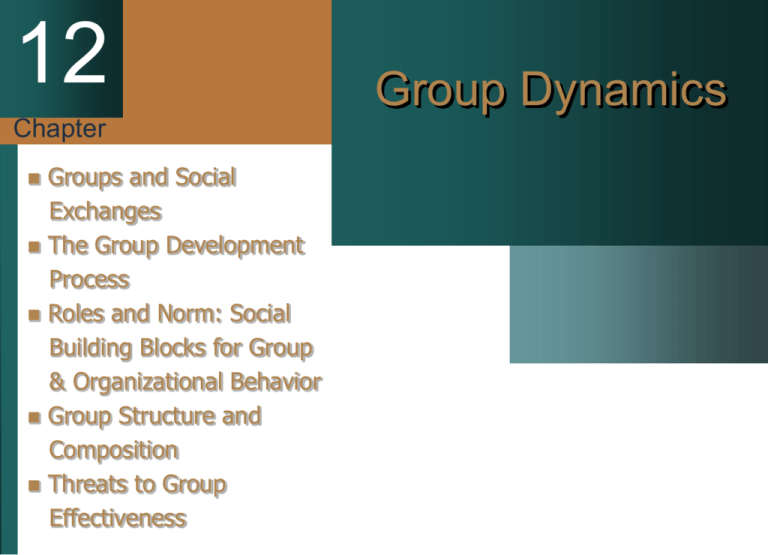
12
Chapter
Groups and Social
Exchanges
The Group Development
Process
Roles and Norm: Social
Building Blocks for Group
& Organizational Behavior
Group Structure and
Composition
Threats to Group
Effectiveness
Group Dynamics
Key Social Skills Managers Need for
Building Social Capital
12-2
Table 12-1
Social Skill
Description
Social perception
Ability to perceive accurately the
emotions, traits, motives and intentions
of others
Impression management
Tactics designed to induce liking a
favorable first impression by others
Persuasion and social influence
Ability to change others’ attitudes
and/or their behavior in desired
direction
Social adaptability
Ability to adapt to, or feel comfortable
in, a wide range of social situations
McGraw-Hill
© 2004 The McGraw-Hill Companies, Inc. All rights reserved.
12-3
Figure 12-1
Sociological Criteria of a Group
Common
identity
4
Collective
norms
2
1
Two or more
Freely interacting
individuals
McGraw-Hill
3
Collective goals
© 2004 The McGraw-Hill Companies, Inc. All rights reserved.
12-4
Groups can be:
1)
Formal – formed by organization to
accomplish organizational and
individual functions
2)
Informal – exists for personal reasons
McGraw-Hill
Table 12-2
© 2004 The McGraw-Hill Companies, Inc. All rights reserved.
Tuckman’s Five-Stage Theory
of Group Development
Performing
12-7
Figure 12-3
Adjourning
Norming
Storming
Forming
Return to
Independence
Dependence/
interdependence
Independence
McGraw-Hill
© 2004 The McGraw-Hill Companies, Inc. All rights reserved.
Tuckman’s Five-Stage Theory
of Group Development
Forming
Individual
Issues
Group
Issues
McGraw-Hill
Storming
Norming
12-8
Figure 12-3 cont.
Performing
“How do I fit
in?”
“What’s my
role here?”
“How can I
“What do the
best
others expect
perform my
me to do?”
role?”
“Why are we
here?”
“Why are we
fighting over
who’s in
charge and
who
does what?”
“Can we agree
“Can we do
on roles and
the
work as a
job properly?”
team?”
© 2004 The McGraw-Hill Companies, Inc. All rights reserved.
12-10
Roles Defined
Role expected
behaviors for a given
position
McGraw-Hill
Task-oriented – giving
and seeking
information,
coordinating activities
Helping – resolving
conflicts, reinforcing
positive behaviors
© 2004 The McGraw-Hill Companies, Inc. All rights reserved.
12-12
Role Outcomes
Role Overload others’ expectations exceed one’s ability
Role Conflict others have conflicting or inconsistent
expectations
Role Ambiguity Others’ expectations are unknown
McGraw-Hill
© 2004 The McGraw-Hill Companies, Inc. All rights reserved.
12-13
Norms
Norm shared attitudes,
opinions, feelings, or
actions that guide social
behavior
McGraw-Hill
© 2004 The McGraw-Hill Companies, Inc. All rights reserved.
12-14
How Norms are Formed
1)
2)
3)
4)
McGraw-Hill
Explicit statements by supervisors or
coworkers
Critical events in the group’s history
Primacy
Carryout behaviors from past situations
© 2004 The McGraw-Hill Companies, Inc. All rights reserved.
12-15
Table 12-4
Why Norms are Enforced
Group/organization
survival
Clarification of behavioral expectations
Avoidance of embarrassment
Clarification of central values/unique identity
McGraw-Hill
© 2004 The McGraw-Hill Companies, Inc. All rights reserved.
Ethnicity and group performance
Ethnically
homogeneous groups perform better
during early stages of development
Ethnically heterogeneous groups develop more
effective, higher quality ideas
Members of homogenous groups are more attracted
to their groups
There is more gender equality in African American
groups than in white American groups
Gender and group performance
Men
interrupt women significantly more than they
interrupt other men
Women interrupt others less frequently and less
successfully
Women moving into male-dominated fields face
greater resistance than males moving into femaledominated fields
Increases social contact between women and men at
work has lead to increased sexualization of the
workplace
Threats to Group Effectiveness:
The Asch Effect
Standard Line Card
Figure 12-5
Comparison Lines
Card
1
McGraw-Hill
12-21
2
3
© 2004 The McGraw-Hill Companies, Inc. All rights reserved.
12-22
Threats to Group Effectiveness: Groupthink
Groupthink term for a
cohesive in-group’s unwillingness
to realistically view alternatives
Symptoms:
McGraw-Hill
Invulnerability
Inherent morality
Rationalization
Stereotyped views of
opposition
Self-censorship
Illusion of
unanimity
Peer pressure
Mindguards
© 2004 The McGraw-Hill Companies, Inc. All rights reserved.
Symptoms of Groupthink Lead to
Defective Decision Making
Symptoms of Groupthink
Invulnerability
Inherent morality
Rationalization
Stereotyped views of
opposition
Self-censorship
Illusion of
unanimity
Peer pressure
Mindguards
McGraw-Hill
12-23
Figure 12-6
Decision-making Defects
1) Few alternatives
2) No reexamination of
preferred alternatives
3) No reexamination of
rejected alternatives
4) Rejection of expert
opinions
5) Selective bias of new
information
6) No contingency plans
© 2004 The McGraw-Hill Companies, Inc. All rights reserved.
12-24
Preventing Groupthink
1)
2)
3)
McGraw-Hill
Each member of the group should be assigned the
role of critical evaluator
Top-level executives should not use company policy
committees to rubber-stamp decisions that have
already been made
Different groups with different leaders should
explore the same policy questions
© 2004 The McGraw-Hill Companies, Inc. All rights reserved.
12-25
Preventing Groupthink Cont.
4)
5)
6)
McGraw-Hill
Subgroup debates and outside experts should be
used to introduce fresh perspectives
Someone should be given the role of devil’s advocate
when discussing major alternatives
Once a consensus has been reached, everyone should
be encouraged to rethink their position to check for
flaws
© 2004 The McGraw-Hill Companies, Inc. All rights reserved.
12-26
Social Loafing
Social Loafing decrease in individual effort as
group size increases
Equity of effort
Loss of personal accountability
Motivational loss due to sharing of rewards
McGraw-Hill
© 2004 The McGraw-Hill Companies, Inc. All rights reserved.






